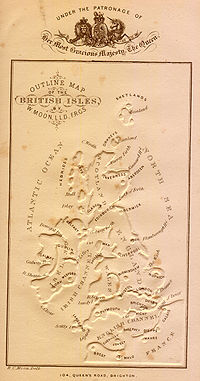
Embossing
Encyclopedia

Paper
Paper is a thin material mainly used for writing upon, printing upon, drawing or for packaging. It is produced by pressing together moist fibers, typically cellulose pulp derived from wood, rags or grasses, and drying them into flexible sheets....
and other materials.
Techniques
Embossing is typically accomplished by applying heatHeat
In physics and thermodynamics, heat is energy transferred from one body, region, or thermodynamic system to another due to thermal contact or thermal radiation when the systems are at different temperatures. It is often described as one of the fundamental processes of energy transfer between...
and pressure
Pressure
Pressure is the force per unit area applied in a direction perpendicular to the surface of an object. Gauge pressure is the pressure relative to the local atmospheric or ambient pressure.- Definition :...
with male and female dies, usually made of copper or brass, that fit together and squeeze the fibers of the substrate. The combination of pressure and heat raises the level of the image higher than the substrate, while "ironing
Ironing
Ironing is the use of a heated tool to remove wrinkles from fabric. The heating is commonly done to a temperature of 180-220 °Celsius, depending on the fabric. Ironing works by loosening the bonds between the long-chain polymer molecules in the fibers of the material...
" it to make it smooth. In printing
Printing
Printing is a process for reproducing text and image, typically with ink on paper using a printing press. It is often carried out as a large-scale industrial process, and is an essential part of publishing and transaction printing....
this is accomplished on a letterpress. The most common machines are the Kluge Letterpress and the Heidelberg Letterpress.
"Debossing" is similar to embossing, but recesses the design rather than raising it.
Most types of paper can be embossed, and size is not normally a consideration. Embossing without ink, so that the image is raised but not colored, is called "blind embossing." Embossing used in conjunction with ink, so that the raised area is colored, is called "color register embossing." Embossing used in conjunction with foil stamping
Foil stamping
Foil stamping, typically a commercial print process, is the application of pigment or metallic foil, often gold or silver, but can also be various patterns or what is known as pastel foil which is a flat opaque color or white special film-backed material, to paper where a heated die is stamped onto...
is called "combination stamping" or "combo stamping."
Embossing involves a separate stage in the production process, after any varnishing and laminating. It requires a separate press run, and is priced accordingly. In addition to being used as a design element, embossing can be used to improve the performance of paper products like napkins, diapers, and tissue paper.
Notary use
A notary publicNotary public
A notary public in the common law world is a public officer constituted by law to serve the public in non-contentious matters usually concerned with estates, deeds, powers-of-attorney, and foreign and international business...
frequently uses embossing to mark legal papers, either in the form of an adhesive seal, or using a clamp-like embossing device used to certify (a signature on a document, contract, etc.) or cause to become certified through a notary public or bill.
Postage stamps
Embossing has been used regularly on postage stampPostage stamp
A postage stamp is a small piece of paper that is purchased and displayed on an item of mail as evidence of payment of postage. Typically, stamps are made from special paper, with a national designation and denomination on the face, and a gum adhesive on the reverse side...
s. The embossed paper of a letter sheet
Letter sheet
In philatelic terminology a Letter sheet, often written lettersheet, is nowadays an item of postal stationery issued by a postal authority. It is a sheet of paper that can be folded, usually sealed , and mailed without the use of an envelope...
or stamped envelope
Stamped envelope
A stamped envelope or postal stationery envelope is an envelope with a printed or embossed indicium indicating the prepayment of postage. It is a form of postal stationery.-Use in the United States:In August 1852 an act of the U.S...
is called an indicium. Notable early examples include some of the earliest stamps of Italy
Italy
Italy , officially the Italian Republic languages]] under the European Charter for Regional or Minority Languages. In each of these, Italy's official name is as follows:;;;;;;;;), is a unitary parliamentary republic in South-Central Europe. To the north it borders France, Switzerland, Austria and...
, Natal, and Switzerland
Switzerland
Switzerland name of one of the Swiss cantons. ; ; ; or ), in its full name the Swiss Confederation , is a federal republic consisting of 26 cantons, with Bern as the seat of the federal authorities. The country is situated in Western Europe,Or Central Europe depending on the definition....
, as well as the early high values of Britain
United Kingdom
The United Kingdom of Great Britain and Northern IrelandIn the United Kingdom and Dependencies, other languages have been officially recognised as legitimate autochthonous languages under the European Charter for Regional or Minority Languages...
. Modern stamps still sometimes use embossing as a design element.

